Information
This note is about the concept of information
Key Issues
Why do we need to look at the concept and the phenomenon of information?
It is important to understand the formation of the world and the relationship of the world to life in order to change that context via design.
Large-scale data- and sensing-driven approaches to management and design stimulate further need.
This need becomes acute when design substantially or deliberately impinges on the lives of nonhuman beings (which is always, to some degree).
Overview
A good overview is:
Logan, Robert K. ‘What Is Information?: Why Is It Relativistic and What Is Its Relationship to Materiality, Meaning and Organization’. Information 3, no. 1 (2012): 68–91. https://doi.org/10/gchqgp.
It is a contested concept with many uses in different domains.
Linguistically and grammatically the word information is a noun but information occurs as a process.
- Is there only one type information or many types of information?
- How does information relate to meaning?
- Is it material, a form of energy or a pattern?
- Is it human only or do other living/nonliving forms have/produce information?
Kind, Amy, ed. The Routledge Handbook of Philosophy of Information. London: Routledge, 2016.
Related
Definitions of Information
Information is the ability to distinguish reliably among possible alternatives. Shannon (the minimal distinction between two possible messages is the fundamental binary "atom", a bit or a binary digit, 0 or 1)
To live effectively is to live with adequate information. Wiener 1
Information is a distinction that makes a difference. MacKay 2
Information is a difference that makes a difference. Bateson 3
Christoph Adami, life is information, information is the ability to make predictions with a likelihood better than chance. Genome is a repository of information about the world gathered in small bits through evolution.
Adami, Christoph. ‘What Is Information?’ Philosophical Transactions of the Royal Society A: Mathematical, Physical and Engineering Sciences 374, no. 2063 (2016): 20150230. https://doi.org/10/gd3tc4.
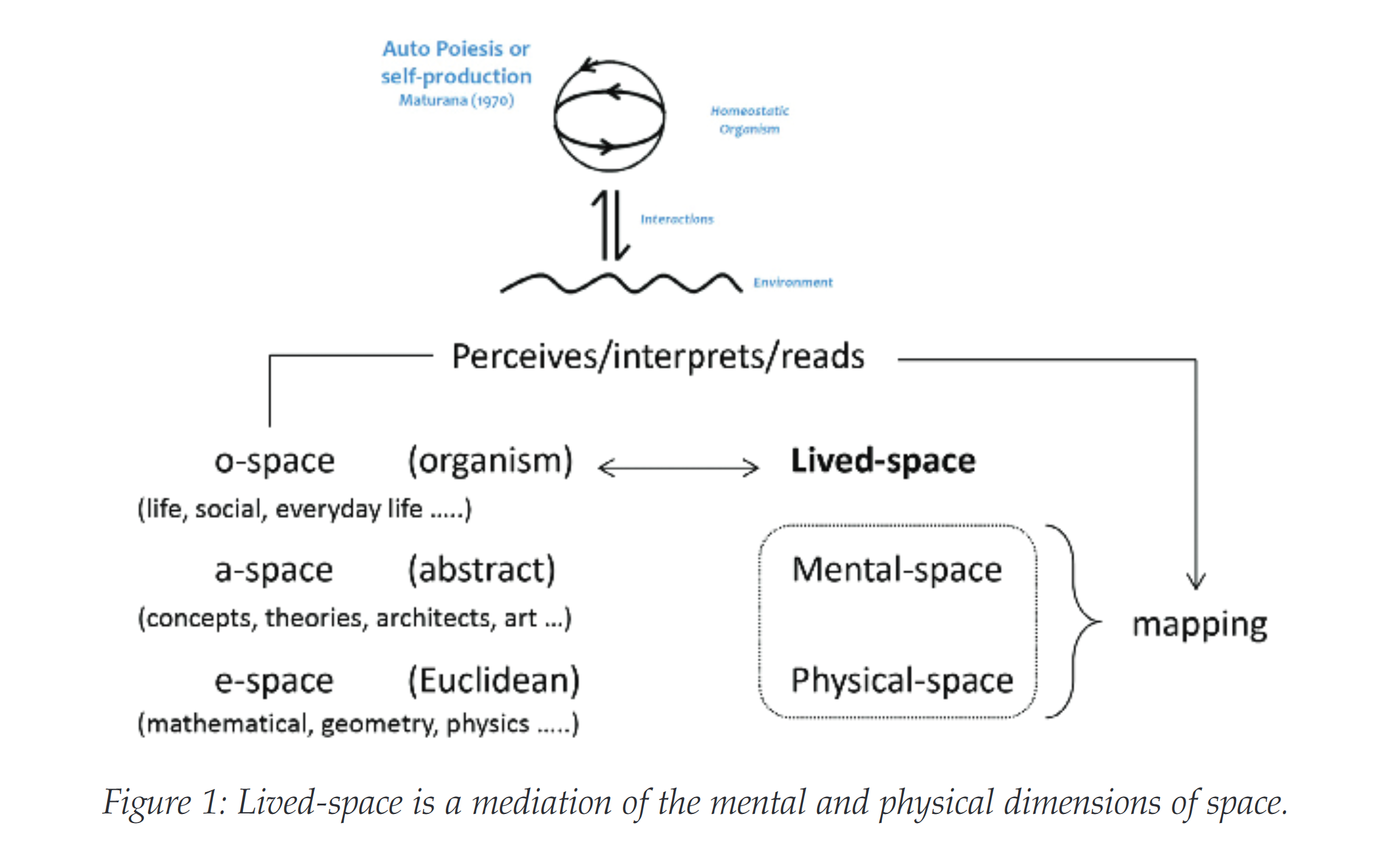
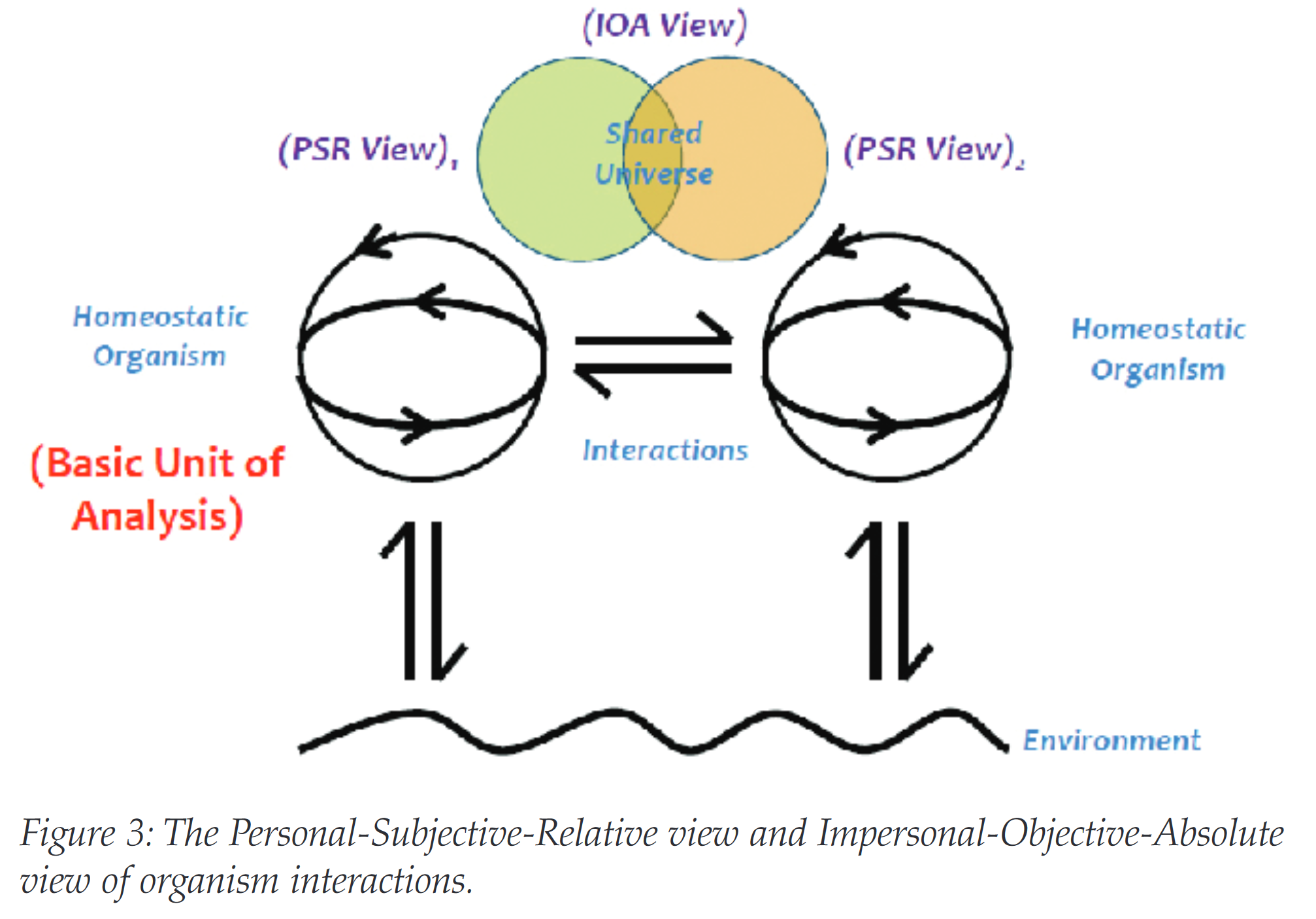
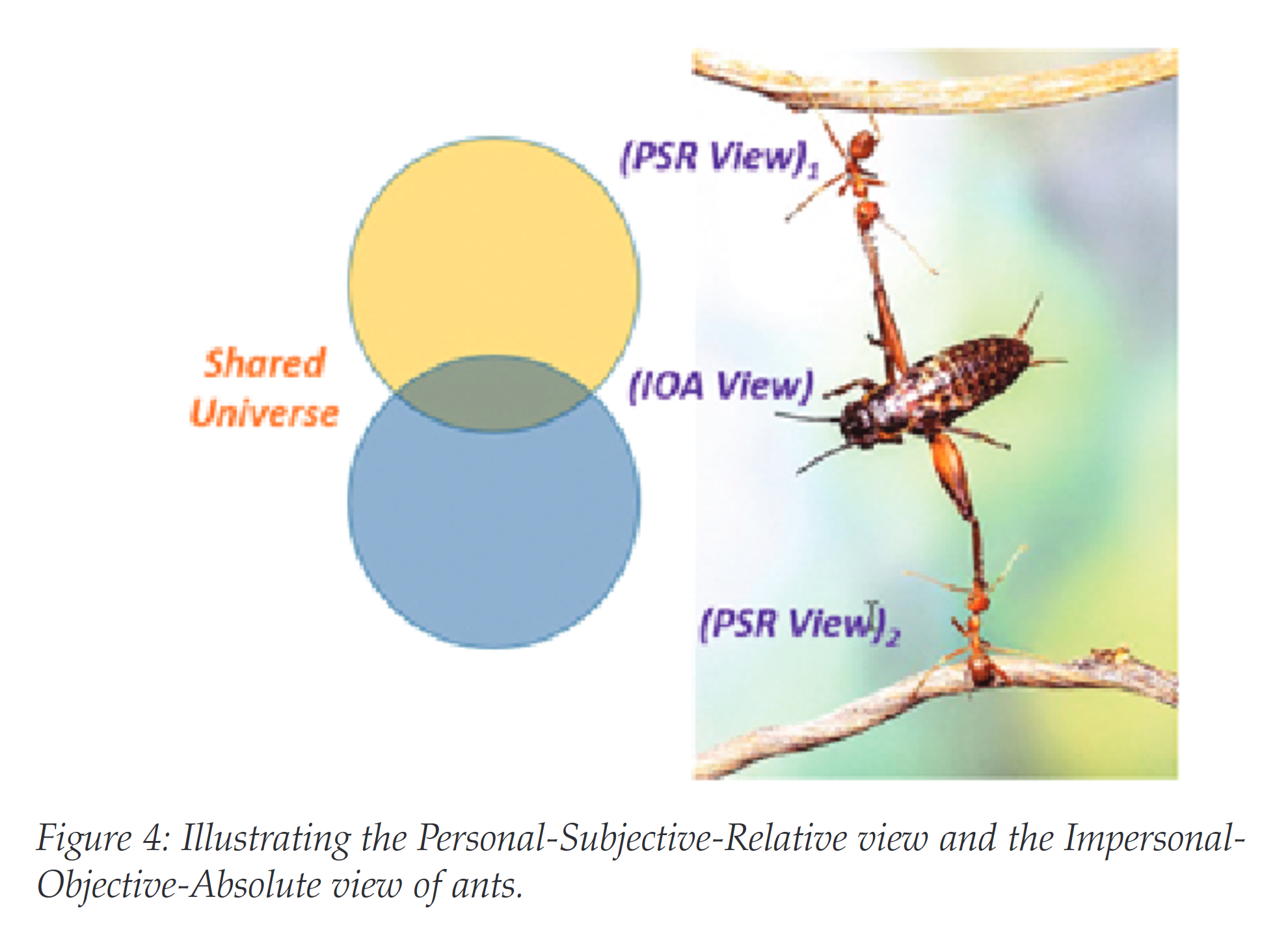
Ireland, Tim, and Jaime F. Cardenas-Garcia. ‘A Teleonomic Distributed Cognition Approach to Architectural Design’. Technoetic Arts 15, no. 1 (1 March 2017): 15–34. https://doi.org/10/gpthzk.
For a recent discussion, see:
Burgin, Mark, and Jaime F. Cárdenas-García. ‘A Dialogue Concerning the Essence and Role of Information in the World System’. Information 11, no. 9 (2020): 406. https://doi.org/10/gptjh7.
For the connection to the digital technology, see:
Cárdenas-García, Jaime F. ‘Info-Autopoiesis and Digitalisation’. Proceedings 81, no. 1 (2022): 82. https://doi.org/10.3390/proceedings2022081082.
On the connection with the overarching theories of the structure of the universe (and its self-learning capabilities), see:
Alexander, Stephon, William J. Cunningham, Jaron Lanier, Lee Smolin, Stefan Stanojevic, Michael W. Toomey, and Dave Wecker. ‘The Autodidactic Universe’. ArXiv:2104.03902, 2021.
Cárdenas-García, Jaime F. ‘The Process of Info-Autopoiesis – the Source of All Information’. Biosemiotics 13, no. 2 (2020): 199–221. https://doi.org/10/gnk7w4.
Barbieri, Marcello. “What Is Information?” Philosophical Transactions of the Royal Society A: Mathematical, Physical and Engineering Sciences 374, no. 2063 (2016): 20150060. https://doi.org/10/gd6fcg.
"Information: any factor that can affect the phenotype in ways that may (or may not) influence fitness. Consequently, phenotypic variation results from variation in the information possessed by individual organisms."
- definitions often refer to how information is used rather than on the facts from which it is extracted
- a fact becomes information once it is detected
- information is analogous to energy in being either potential or realized
Danchin, Étienne. “Avatars of Information: Towards an Inclusive Evolutionary Synthesis.” Trends in Ecology & Evolution 28, no. 6 (2013): 351–58. https://doi.org/10/f429ff.
Cf. their definition of Culture.
"Information: a reduction in uncertainty that can be quantified in a Bayesian sense by comparing a prior knowledge state to a posterior state (sensu 7). Information Ecology is not tied to any specific measurement but, for simplicity, we can estimate uncertainty in terms of the ‘probability of being wrong’ so that it ranges from 0 to 1. This probability is a product of the state space and previously obtained information. For example, without any prior knowledge, the probability of being wrong is higher for a four-sided dice than a two-sided dice (0.75 vs. 0.50). This uncertainty can be reduced with information (e.g., learning that the dice is weighted to always land on two would bring the uncertainty to 0 in both cases) and the quantity of information is measured as the reduction in uncertainty (0.75 or 0.50). Information ranges from -1 to 1, with negative information indicating a gain in uncertainty."
Bergman, Thore J., and Jacinta C. Beehner. “Information Ecology: An Integrative Framework for Studying Animal Behavior.” Trends in Ecology & Evolution 38, no. 11 (2023): 1041–50. https://doi.org/10/gst66t.
Information, Computation, and Nature
Dodig-Crnkovic, Gordana. ‘Nature as a Network of Morphological Infocomputational Processes for Cognitive Agents’. The European Physical Journal Special Topics 226, no. 2 (2017): 181–95. https://doi.org/10/f3t2ph.
Infocomputation as a way to understand ecology and sustainability.
Brenner, Joseph E. ‘The Philosophy of Ecology and Sustainability: New Logical and Informational Dimensions’. Philosophies 3, no. 2 (2018): 16. https://doi.org/10/grp3m3.
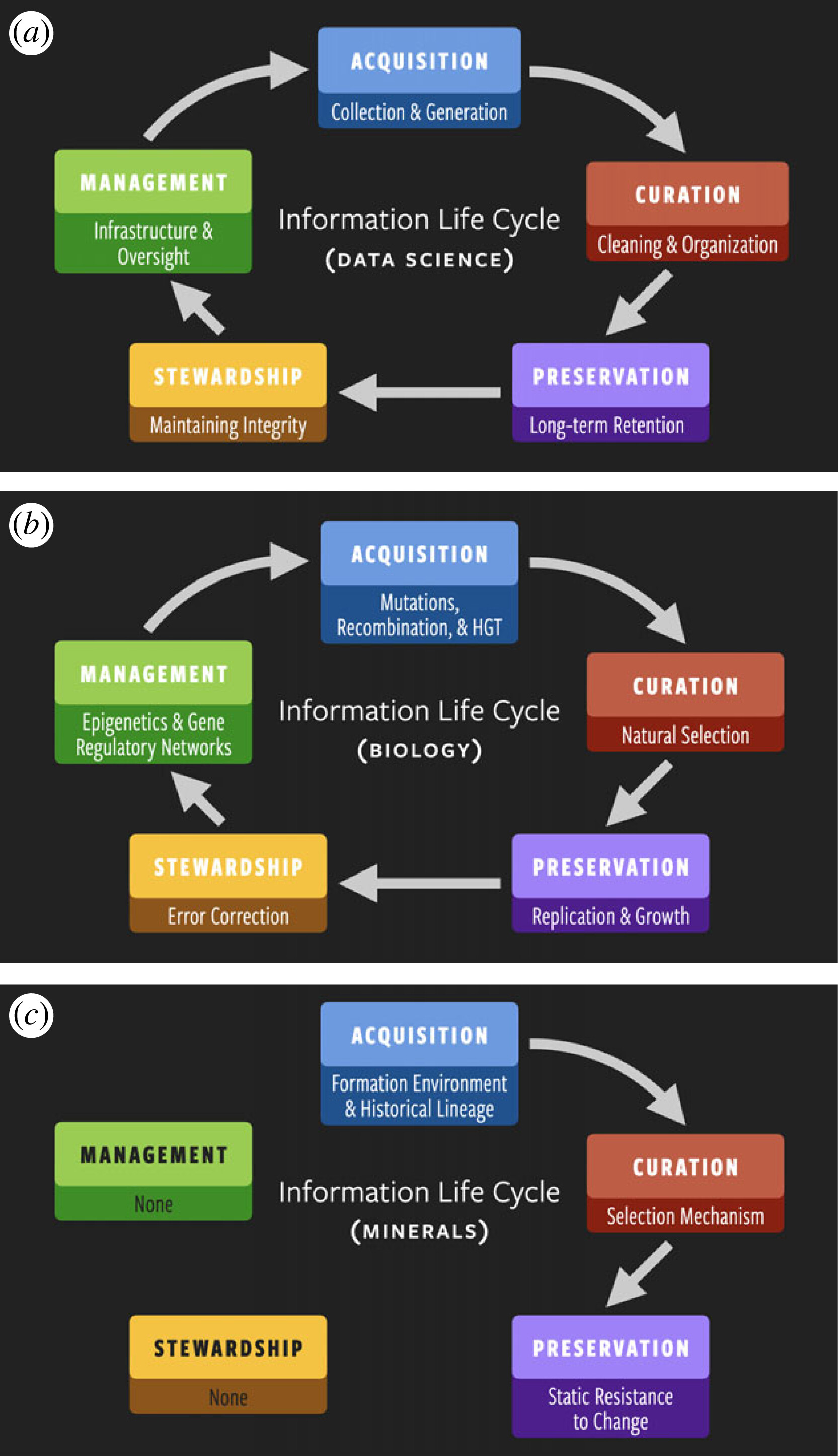
Wong, Michael L., and Anirudh Prabhu. ‘Cells as the First Data Scientists’. Journal of The Royal Society Interface 20, no. 199 (2023): 20220810. https://doi.org/10/gr542v.
Information and Life
"Every process, event, happening—call it what you will; in a word, everything that is going on in Nature means an increase of the entropy of the part of the world where it is going on. Thus a living organism continually increases its entropy—or, as you may say, produces positive entropy—and thus tends to approach the dangerous state of maximum entropy, which is death. It can only keep aloof from it, i.e., alive, by continually drawing from its environment negative entropy—which is something very positive as we shall immediately see. What an organism feeds upon is negative entropy. Or, to put it less paradoxically, the essential thing in metabolism is that the organism succeeds in freeing itself from all the entropy it cannot help producing while alive." 4
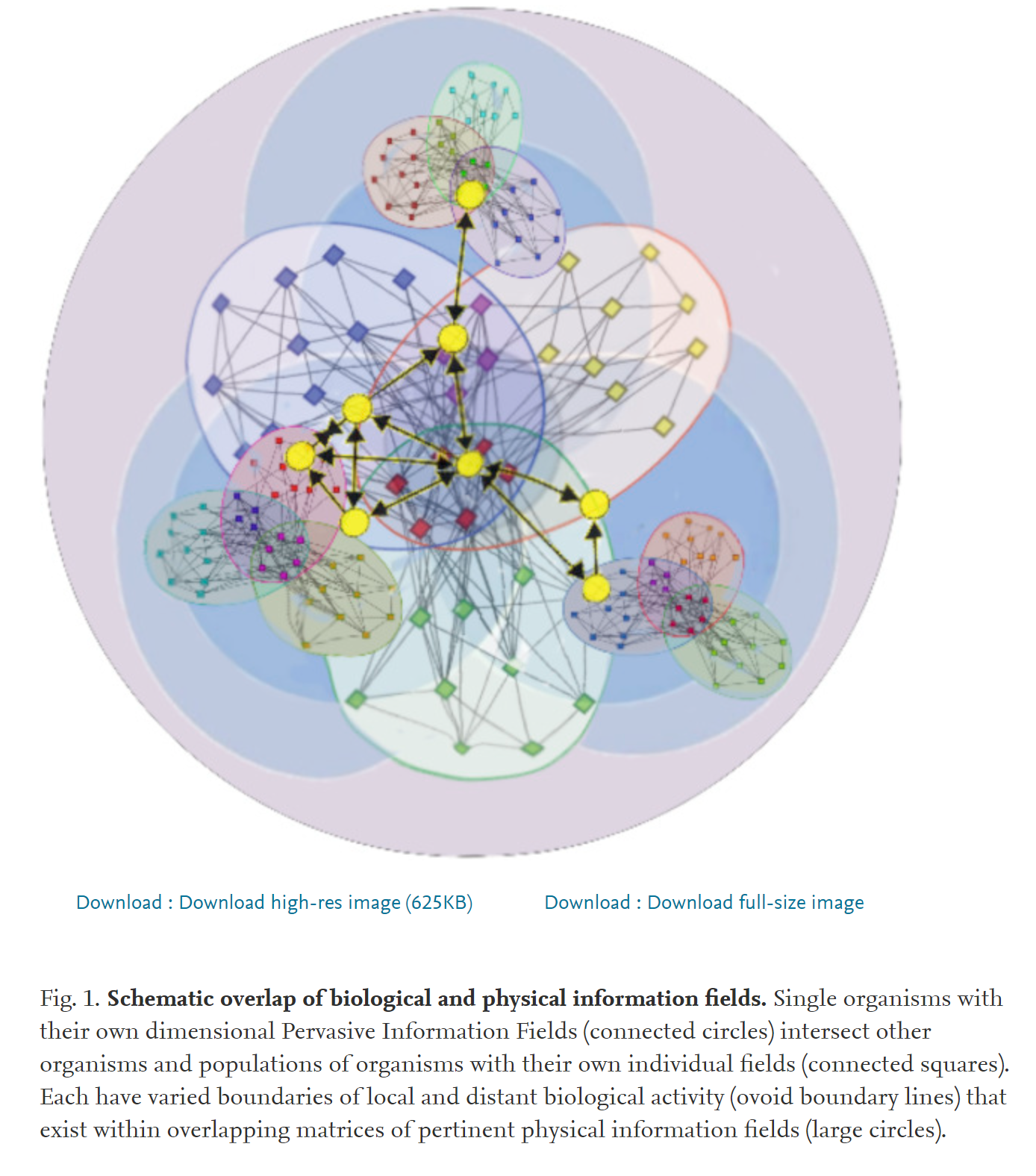
Miller, William B. ‘Biological Information Systems: Evolution as Cognition-Based Information Management’. Progress in Biophysics and Molecular Biology 134 (2018): 1–26. https://doi.org/10/ghqpft.
Evolutionary biology as an epiphenomenon of integrated self-referential information management.
Since all biological information has inherent ambiguity, living organisms have to systematically assess to maintain self-identity and homeostatic equipoise in confrontation with environmental challenges.
Miller, William B., John S. Torday, and František Baluška. ‘Biological Evolution as Defense of “Self”’. Progress in Biophysics and Molecular Biology 142 (2019): 54–74. https://doi.org/10/ggfgh7.
Küppers, Bernd-Olaf. Information and the Origin of Life. Cambridge, MA: MIT Press, 1990.
Yockey, Hubert P. Information Theory, Evolution, and the Origin of Life. Cambridge: Cambridge University Press, 2005.
Walker, Sara Imari, and Paul C. W. Davies. “The Algorithmic Origins of Life.” Journal of The Royal Society Interface 10, no. 79 (2013): 20120869. https://doi.org/10/gd6fmt.
Roederer, Juan G. Information and Its Role in Nature. Berlin: Springer, 2005.
Davies, Paul C. W., and Sara Imari Walker. “The Hidden Simplicity of Biology.” Reports on Progress in Physics 79, no. 10 (2016): 102601.
Compression
Cf. Abstraction
A common idea in studies of sensory processing.
The view that brain is an device for compressing information. Generally, that intelligence and cognition are mechanisms that gather, synthesize, compress, and convert unstructured information into useful and exploitable knowledge, cf. Demis Hassabis, of DeepMind, Stanislas Dehaene.
"Internal knowledge may be inaccurate or incomplete due to errors in sensory measurements. Some features of the environment may also be encoded inaccurately to minimize representational costs associated with their processing."
Motiwala, Asma, Sofia Soares, Bassam V. Atallah, Joseph J. Paton, and Christian K. Machens. “Efficient Coding of Cognitive Variables Underlies Dopamine Response and Choice Behavior.” Nature Neuroscience 25, no. 6 (2022): 738–48. https://doi.org/10/gqcskh.
Wolff, J. Gerard. “Information Compression as a Unifying Principle in Human Learning, Perception, and Cognition.” Complexity, 2019, e1879746. https://doi.org/10/gk78h9.
Information in Context
This also related to Knowledge and Abstraction
- Data are the pure and simple facts without any particular structure or organization, the basic atoms of information,
- Information is structured data, which adds more meaning to the data and gives them greater context and significance,
- Knowledge is the ability to use information strategically to achieve one's objectives, and
- Wisdom is the capacity to choose objectives consistent with one's values and within a larger social context.5
Information in Biology
Shannon's information is agnostic to function or meaning. by contract, biological information has to be semantic, or functional. The focus here is on the evolution of the receiver (we could call this representation?).
"A source—an entity or a process—can be said to have information when a receiver system reacts to this source in a special way. The reaction of the receiver to the source has to be such that the reaction can actually or potentially change the state of the receiver in a (usually) functional manner. Moreover, there must be a consistent relation between variations in the form of the source and the corresponding changes in the receiver." 6
Cognition limits the flow of information flow as determined by the life history of an organism, de Waal
Dickins, Thomas E. “Data and Context.” Biosemiotics 14, no. 3 (2021): 633–42. https://doi.org/10/gqd39r.
Cf. "control information". Intends to measure the functional (content and meaning) role of information in cybernetic processes (such as in living systems). "It is defined as: the capacity (know how) to control the acquisition, disposition and utilization of matter/energy in ‘purposive’ (cybernetic) processes." Can be measured as the quantity of available energy that can be controlled by a given unit of information in a given context. Other metrics are also possible including money or labour (time and energy).
Corning, Peter A. ‘Control Information Theory: The “Missing Link” in the Science of Cybernetics’. Systems Research and Behavioral Science 24, no. 3 (2007): 297–311. https://doi.org/10/dp3h37.
O’Connor, Mary I., Matthew W. Pennell, Florian Altermatt, Blake Matthews, Carlos J. Melián, and Andrew Gonzalez. ‘Principles of Ecology Revisited: Integrating Information and Ecological Theories for a More Unified Science’. Frontiers in Ecology and Evolution 7 (2019). https://doi.org/10/gkdx4q.
Szymkowiak, Jakub, and Kenneth A. Schmidt. ‘Ecology of Information Enters the Anthropocene’. Oikos 2022, no. 10 (2022): e09677. https://doi.org/10/gsm5w9.
Cf. the agential perspective in Agency.
Biological information is best understood as the interpretation (or processing) of inputs, rather than as an inherent property of inputs. It is best to define it in terms of the receiver system. A source becomes an informational input when an interpreting receiver can react to the form of the source (and variations in this form) in a functional manner.
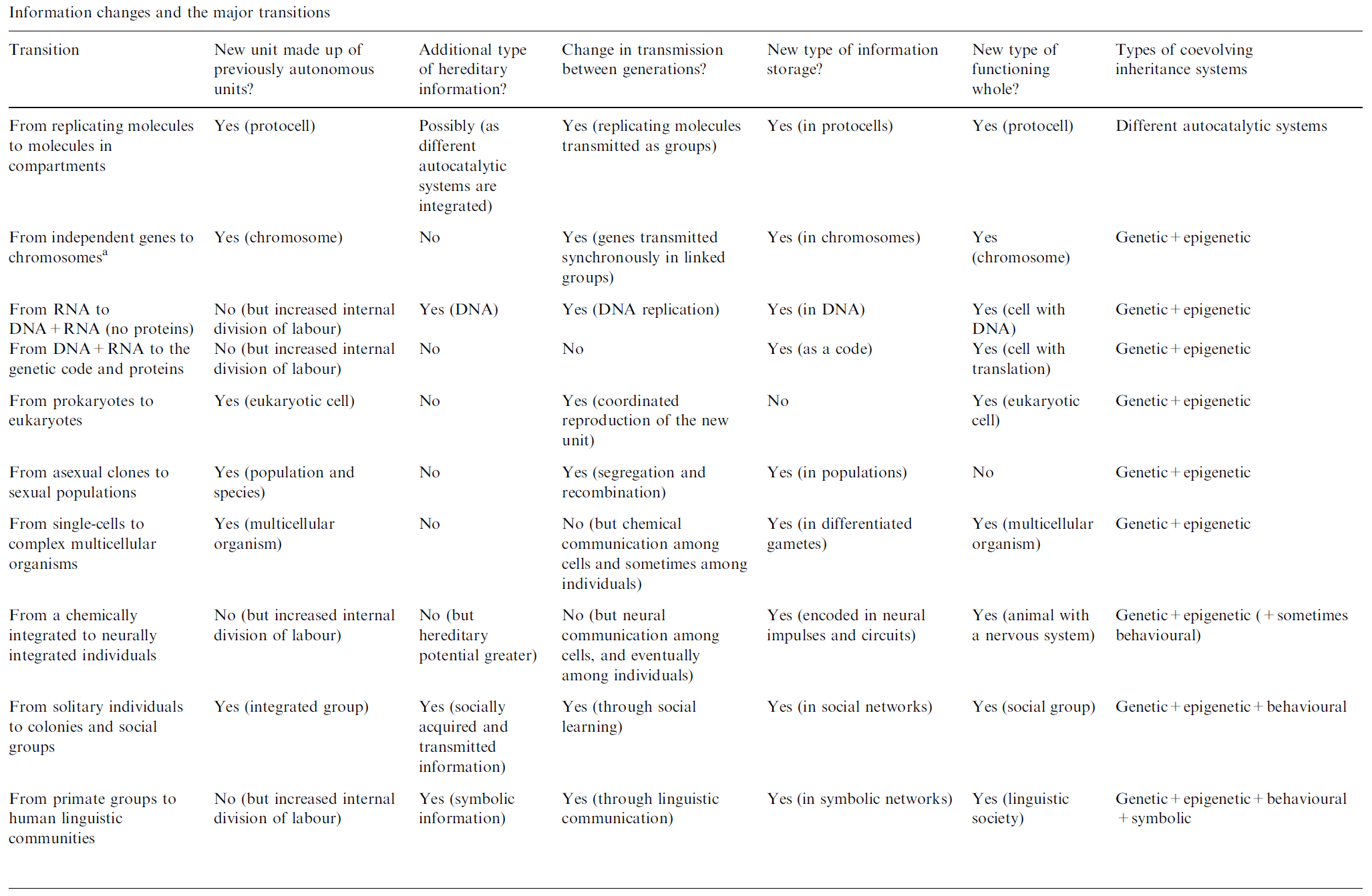
Jablonka, Eva, and Marion J. Lamb. ‘The Evolution of Information in the Major Transitions’. Journal of Theoretical Biology 239, no. 2 (2006): 236–46. https://doi.org/10/fht8hq.
Jablonka, Eva. ‘Information: Its Interpretation, Its Inheritance, and Its Sharing’. Philosophy of Science 69, no. 4 (2002): 578–605. https://doi.org/10/cwmsjs.
Can we redraw this table to include machinic means for storing and transmitting information?
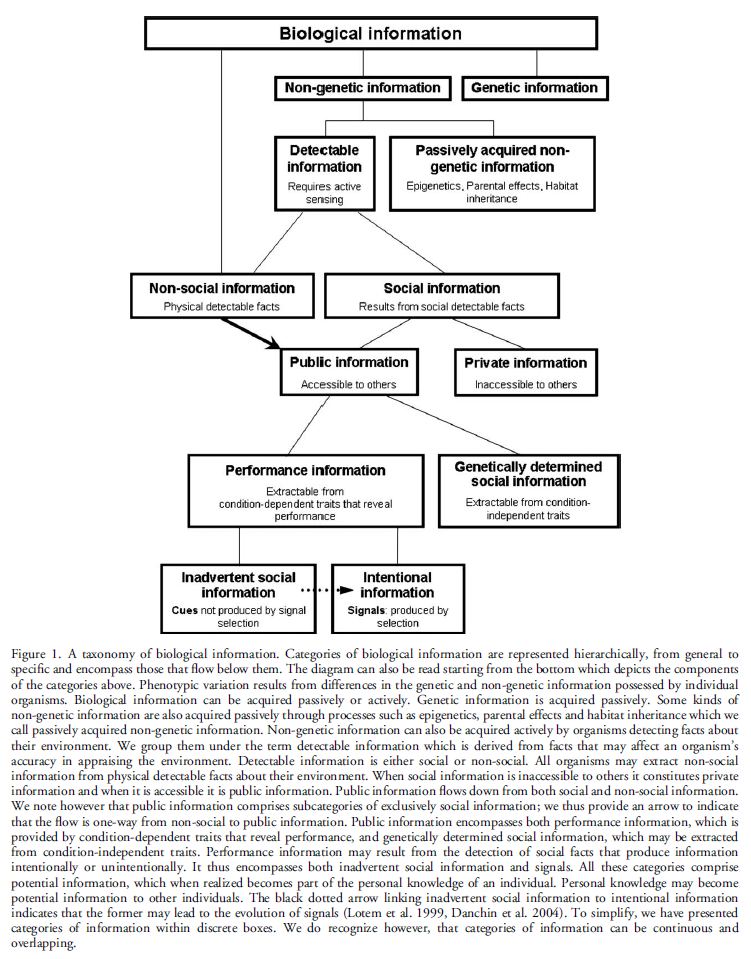
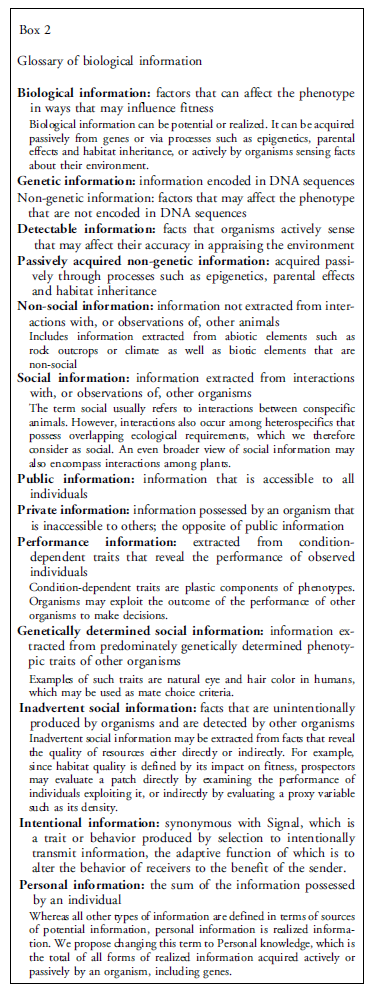
Wagner, Richard H., and Étienne Danchin. “A Taxonomy of Biological Information.” Oikos 119, no. 2 (2010): 203–9. https://doi.org/10/fg8455.
Cognitive Ecology, Ecology of Information
Cf. Agency
Dukas, Reuven, ed. Cognitive Ecology: The Evolutionary Ecology of Information Processing and Decision Making. Chicago: University of Chicago Press, 1998.
Jablonka, Eva, and Marion J. Lamb. ‘The Evolution of Information in the Major Transitions’. Journal of Theoretical Biology, 239, no. 2 (2006): 236–46. https://doi.org/10/fht8hq.
Jablonka, Eva. ‘Information: Its Interpretation, Its Inheritance, and Its Sharing’. Philosophy of Science 69, no. 4 (2002): 578–605. https://doi.org/10/cwmsjs.
Little, Chelsea J., Matteo Rizzuto, Thomas M. Luhring, Julia D. Monk, Robert J. Nowicki, Rachel E. Paseka, James C. Stegen, Celia C. Symons, Frieda B. Taub, and Jian D. L. Yen. ‘Movement with Meaning: Integrating Information into Meta-Ecology’. Oikos 2022, no. 8 (2022): e08892. https://doi.org/10/gp99rx.
Schmidt, Kenneth A., Sasha R. X. Dall, and Jan A. Van Gils. ‘The Ecology of Information: An Overview on the Ecological Significance of Making Informed Decisions’. Oikos 119, no. 2 (2010): 304–16. https://doi.org/10/b9zbhf.

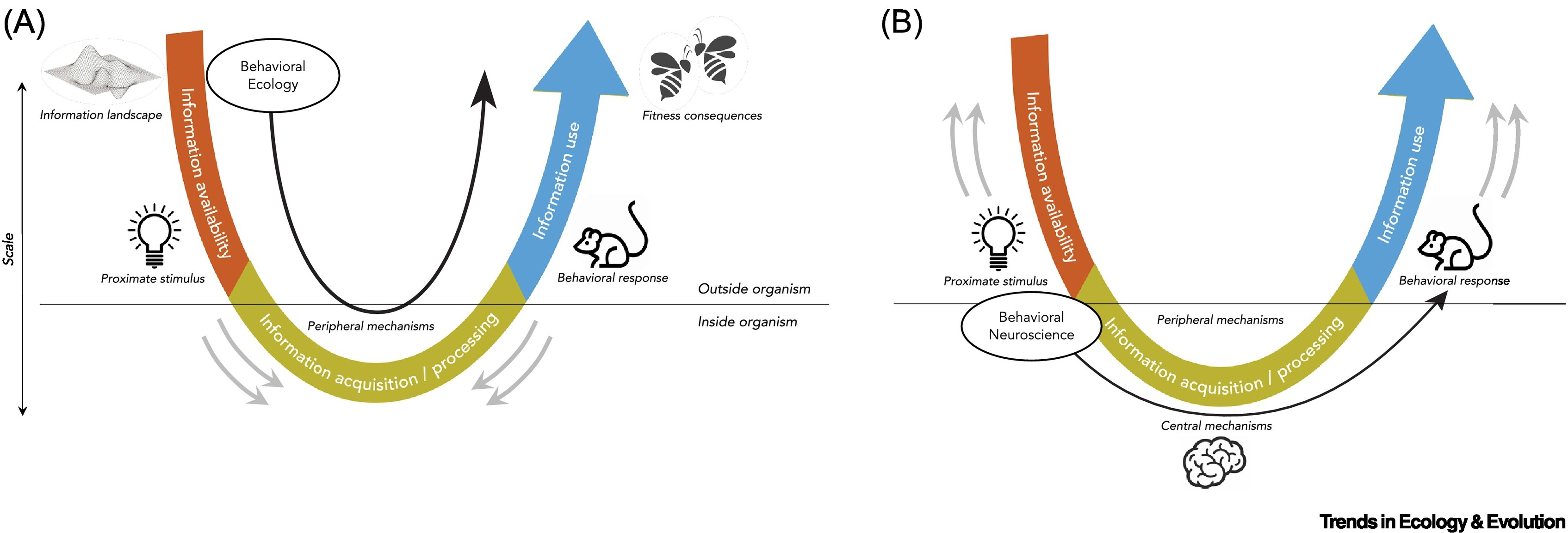

This one focuses on animals only but useful nonetheless.
Bergman, Thore J., and Jacinta C. Beehner. “Information Ecology: An Integrative Framework for Studying Animal Behavior.” Trends in Ecology & Evolution 38, no. 11 (2023): 1041–50. https://doi.org/10.1016/j.tree.2023.05.017.
Unified Views on Information
Robinson, Lyn, and David Bawden. ‘Mind the Gap: Transitions Between Concepts of Information in Varied Domains’. In Theories of Information, Communication and Knowledge: A Multidisciplinary Approach, edited by Fidelia Ibekwe-SanJuan and Thomas M. Dousa, 121–41. Dordrecht: Springer, 2014.
Terzis, George, and Robert Arp, eds. Information and Living Systems: Philosophical and Scientific Perspectives. Cambridge, MA: MIT Press, 2011.
Dodig Crnkovic, Gordana, and Mark S. Burgin, eds. Philosophy and Methodology of Information: The Study of Information in a Transdisciplinary Perspective. New Jersey: World Scientific, 2019.
Physical Computation
Informational view of the universe, nature, etc.
Dodig Crnkovic, Gordana. ‘Physical Computation as Dynamics of Form That Glues Everything Together’. Information 3, no. 2 (2012): 204–18. https://doi.org/10/f24mgs.
Dodig-Crnkovic, Gordana. ‘Natural Computational Architectures for Cognitive Info-Communication’. ArXiv:2110.06339 [Cs, q-Bio], 2021. http://arxiv.org/abs/2110.06339.
Vedral, Vlatko. Decoding Reality: The Universe As Quantum Information. Oxford: Oxford University Press, 2018.
Sayings and Perspectives
Muriel Rukeyser: "the universe is made of stories, not of atoms."
(This is only mentioned in passing in a poem about ... emotions? The Speed of Darkness, 1968)
Kurzweil describes himself "as a "patternist," someone who views patterns of information as the fundamental reality. For example, the particles composing my brain and body change within weeks, but there is a continuity to the patterns that these particles make. A story can be regarded as a meaningful pattern of information, so we can interpret Muriel Rukeyser's aphorism from this perspective."
Evolution (biological, cultural and technical) is a process of creating patterns of increasing order.
Order is information that fits a purpose. The measure of order is the measure of how well the information fits the purpose. For biological beings, the purpose is to survive.
Kurzweil, Ray. The Singularity Is Near: When Humans Transcend Biology. New York: Viking, 2005.
References
Burgin, Mark. Theory of Information: Fundamentality, Diversity and Unification. Hackensack: World Scientific, 2010.
Hofkirchner, Wolfgang. Emergent Information: A Unified Theory of Information Framework. Singapore: World Scientific, 2013.
Schumacher, Benjamin. The Science of Information: From Language to Black Holes. Chantilly: The Great Courses, 2018.
Scharf, Caleb, and Olaf Witkowski. “Rebuilding the Habitable Zone from the Bottom up with Computational Zones.” Astrobiology 24, no. 6 (2024): 613–27. https://doi.org/10/gt7gqp.
Footnotes
Weiner, Norbert. The Human Use of Human Beings. Boston: Houghton Mifflin, 1950.˄
MacKay, Donald M. Information, Mechanism and Meaning. 1969. Reprint, Cambridge, MA: MIT Press, 1969.˄
Bateson, Gregory. Steps to an Ecology of Mind: Collected Essays in Anthropology, Psychiatry, Evolution, and Epistemology. 1972. Reprint, Northvale: Aronson, 1987.˄
Dall, Sasha R. X., Luc-Alain Giraldeau, Ola Olsson, John M. McNamara, and David W. Stephens. “Information and Its Use by Animals in Evolutionary Ecology.” Trends in Ecology & Evolution 20, no. 4 (April 1, 2005): 187–93. https://doi.org/10/dhkr3v.˄
Schrödinger, Erwin. ‘What Is Life?’ In What Is Life? The Physical Aspect of the Living Cell; with, Mind and Matter and Autobiographical Sketches, Part 1. 1944. Reprint, Cambridge: Cambridge University Press, 1992.˄
Logan, Robert K., and Louis W. Stokes. Collaborate to Compete: Driving Profitability in the Knowledge Economy. Etobicoke: Wiley, 2003.˄
Jablonka, Eva. ‘Information: Its Interpretation, Its Inheritance, and Its Sharing’. Philosophy of Science 69, no. 4 (2002): 578–605. https://doi.org/10/cwmsjs, 582.˄
Backlinks